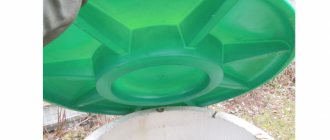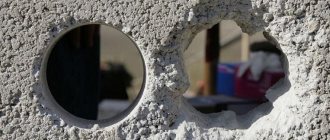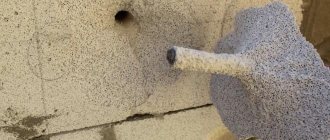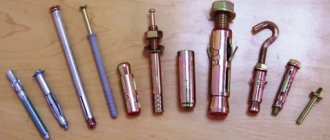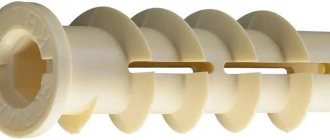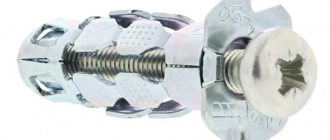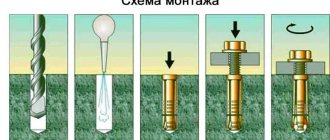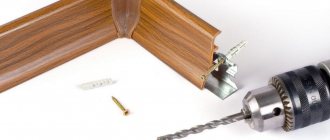SHARE ON SOCIAL NETWORKS
FacebookTwitterOkGoogle+PinterestVk
The dowel is the most popular fastener, which is used for reliable fixation of any structure or element to a solid surface. The principle of its operation is based on the emergence of a friction force, which arises as a result of its expansion in the thickness of the base under the influence of a screw or screw that is screwed into it. The solution to the question of how to install a dowel in the wall will depend on the type of fastener and type of surface.
Dowels are necessary to firmly hold screws and self-tapping screws inside the hole
Dowel: This is a fastener used to secure a fastener.
In order to attach the structure to the base, various fastening options are used. To ensure their reliable adhesion to the surface, various products are used, which include dowels (or dowels).
Dowels securely fix the screws inside the wall
A dowel is a sleeve or sleeve that is inserted into a hole in the wall. The design consists of two parts: spacer and non-spacer. A screw is screwed into the sleeve, which helps expand the spacer part, forming a reliable connection between the dowel and the base. The non-expandable part of the product eliminates the possibility of the screw turning in the hole.
In the upper part of the dowel for the self-tapping screw there is a cuff of a cylindrical, mushroom-shaped or countersunk type, which prevents the screw from falling into the thickness of the base. The predecessor of the dowel was an ordinary wooden block, which was screwed into the wall, into which a nail was subsequently driven.
Modern dowels are presented in a wide variety of species. They can be used on a variety of surface types, including heavy and porous concrete, brick, natural stone, cinder block, drywall, plaster. Dowels are available in lengths of 40-140 mm in increments of 20 mm. The internal diameter of the hole is 5-7 mm. The outer section of the product is 6-10 mm. Each product model has a symbol consisting of two values: hole diameter and length, which eliminates the need to solve the question of how to measure the diameter of the dowel.
Important! Dowels are selected based on the thickness of the material that needs to be fixed, and are designed for values of 10-100 mm, since it is important that the product enters the base to a sufficient depth to open the spacer part.
There are different types of dowels for different types of surfaces
The main advantages of using dowels:
- reliability;
- easy entry into any surface using impact;
- reliable adhesion of products to the base;
- rigid fixation in any surface, including porous, which eliminates the possibility of the fastening element spontaneously falling out;
- lack of torque in loose holes;
- ability to withstand heavy loads without changing the original position;
- durability.
Drive a nail using a cork
Wooden plugs - chopiki
In cases where replacing a nail is not permissible, they resort to using a wooden plug, called by many a chopik.
It is cut out of wood and adjusted to the required dimensions.
The length corresponds to the depth of the hole; one tip is made in the shape of a cone for better fit.
The width of the other edge is left 2-3 mm larger than the hole. If you don’t want or have the opportunity to make a chop yourself, you can buy it in a store by choosing the appropriate size.
You can make a cut in the sharp tip of the chopik and insert a small wedge. By reaching the bottom of the hole, it will increase the strength of the connection between the chop and the wall.
So, hammering a nail into a concrete wall without a drill will be much easier. The soft, wooden surface of the chopik will replace the hard material of the wall. You just need to carefully, slowly hammer in the nail and you're done.
You can easily screw a self-tapping screw or screw into a clogged recess. This can be made more convenient with the help of special plastic plugs, which are sold in stores. Then, you don’t have to take the chopik into account. By inserting the dowel into the recess made by the skewer, the self-tapping screw is easily screwed in.
The use of wooden plugs is also not necessary. It is enough to fill the hole with a solution consisting of cement or alabaster, then insert a screw, the screws of which are pre-wrapped with wire and blotted with a raster.
A hole in the wall without drilling, dust and dirt - on video:
Related article: How to decorate a brick wall with your own hands
Noticed a mistake? Select it and press Ctrl+Enter to let us know.
Material for making dowels
Most dowels are made from polymer materials - polyethylene, polypropylene and polyamide. Such elements are characterized by high performance, availability, ease of installation (there is no need to make significant efforts to attach them) and low cost.
Common materials for making dowels are polyethylene, polypropylene and polyamide
Products made from polypropylene are hard, wear-resistant, and resistant to high temperatures. Such elements are intended exclusively for indoor installation, which is due to their sensitivity to sub-zero temperatures. During long-term operation with temperature fluctuations, deformation of the dowels and the appearance of cracks may occur.
Polyethylene dowels are characterized by low weight, ductility, ability to operate at low temperatures and low cost.
The most reliable and durable products are dowels made of polyamide or nylon. They are characterized by high wear resistance, resistance to mechanical stress and temperature changes.
Dowels can also be made of metal. For this purpose, stainless steel, galvanization, alloys based on bronze or brass are used. Iron dowels are distinguished by high strength qualities, rigidity, the ability to withstand large mechanical loads and durability without compromising the integrity of the structure.
Important! The surface of the metal dowels has a special galvanized coating that prevents the formation of corrosion.
Metal dowel
Removing fasteners
When renovating an apartment, high-quality wall finishing is necessary. To prepare a room for wallpapering or applying any other decorative coating, it is necessary to level the walls, first freeing them from old fasteners.
Often you need to remove unnecessary dowels through which screws are attached. To do this, there are several simple ways to remove a dowel from a concrete wall.
For dismantling you will need:
- Self-tapping screw;
- Sharp knife;
- Corkscrew;
- Awl;
- Hammer;
- Punch;
- Soldering iron;
- Nail puller;
- "Bulgarian".
Dismantling method:
- To remove a regular plastic dowel, you can use a self-tapping screw of a suitable size. In this case, the self-tapping screw is screwed two-thirds into the dowel for a reliable connection with the part being dismantled. The head of the screw is clamped with pliers and pulled out together with the dowel. Sometimes you can use a regular table corkscrew;
- The head of the self-tapping screw screwed into the dowel is pryed off with a nail puller. Using this lever, the dowel is removed with less effort. But the main condition is a tight fit of the working part of the screw in the hole;
- The homemade wooden dowel is removed from the socket in parts. To do this, the element is crushed into several pieces along the wood fibers with a chisel with a thin blade and a hammer. After destruction, the dowel is carefully pryed up with a nail, the tip of a sharp knife or an awl, and pulled out;
- If the dowel sits firmly enough in the wall, it is not always worth pulling it out. In this case, with a sharp knife you need to cut off the part of the dowel that protrudes above the surface of the wall, and cover the resulting depression with construction plaster and carefully level it;
- When removing a dowel in which a piece of screw is stuck, use a heated soldering iron. The tool melts the plastic base of the dowel, then the piece of fastener is pryed off with wire cutters or pliers and pulled out of the socket;
- A metal dowel-nail driven into concrete with a construction gun should first be treated with frequent, fairly strong hammer blows on the protruding part of the part from different sides. Most often, the dowel becomes loose, and then it is relatively easily pulled out with a nail puller;
- If you cannot immediately loosen the metal dowel, you need to make a recess in the wall next to it using a drill with a carbide tip or a metal punch. This circular funnel reduces the adhesion area of the product to the wall material, which will make dismantling much easier. If this does not help, the protruding part of the dowel needs to be cut off with a grinder and the recess should be leveled.
https://youtube.com/watch?v=kdW62uNlPdQ
To determine which dowel is best for concrete, you need to get acquainted with their types, advantages and disadvantages. In addition, it is worth understanding the technology for installing the product, and carefully following the basic construction rules when performing work.
Types of fasteners
Construction stores offer a wide range of dowels. Photos of products clearly demonstrate the diversity of their designs, materials of manufacture and purpose.
The most common product is the universal polypropylene dowel. It has a traditional design in the form of a sleeve, into the cavity of which a self-tapping screw is screwed. This element is suitable for concrete, brick and stone foundations. The design of the product is equipped with special spacers, with the help of which the element is securely fixed in the hole.
To perform complex external work, a spacer construction dowel with a locking edge is used, which eliminates the possibility of fasteners falling into the hole.
Nylon dowels are equipped with fastening antennae, thanks to which the products are securely fixed in the holes. They can be used on any surface.
Drywall dowels are used for mounting them into porous concrete and sheets of gypsum fiber and plasterboard. They can be made of plastic or metal. The last option is called dowel molly. Before hammering in a dowel of this type, there is no need to first prepare the hole, since its tip has the appearance of a sharpened drill.
Dowel for plasterboard walls
Facade dowels are made of polypropylene or nylon. They have directional antennae for secure fixation at the base. Such fasteners can be used for any surface. They are produced without sides, which eliminates the possibility of shedding or cracking of the facing plaster.
The frame dowel is intended for installation of door and window frames, cladding through layers of thermal insulation and plaster. The products are made of metal. They are often called thermal insulation dowels, which can be of two types: for working with hard and soft materials.
Types of dowels with special design
Dowel nails are made of polypropylene, nylon or stainless steel. Thanks to the presence of knurling in the form of reverse cones, reliable retention of the product in the base is ensured. They are widely used for quick and extensive installation of skirting boards, sheathing, windows, timber, metal profiles, cable ducts, plywood to concrete, brick or stone surfaces.
Helpful advice! When deciding whether to hammer or tighten a dowel-nail, preference is given to the first installation option.
Butterfly dowel for hollow structures
The butterfly dowel is characterized by increased wear resistance and the ability to withstand high loads even in hollow surfaces. Such products are made of metal.
The adjusting dowel is used to install the sheathing under the sheathing. It has a special design containing a certain element that allows you to adjust the position of the product relative to the surface to which it is attached.
Helpful advice! To carry out large volumes of installation work, it is advisable to use dowels-screws designed for mounting guns.
The dowel-clamp has the shape of a loop with characteristic tendrils for fastening along the edges of the product. Such elements are designed for mounting electrical wiring to the base. The wire is inserted into the clamp, and its edges, in turn, are inserted into holes previously created in the wall and fixed with tendrils.
A special type of fastening element is an umbrella dowel, which is designed for installing thermal insulation made of polystyrene or mineral wool. This product has a wide round cap that holds the insulation. They produce plastic and metal dowels.
An umbrella dowel is often used to hang ceiling chandeliers
Helpful advice! The best option for loose foundations would be liquid dowels, or chemical anchors, which provide a strong and reliable connection and are at the same time able to withstand heavy loads.
The Molly umbrella dowel is a nail with metal arms that provide reliable fastening of structures to hollow surfaces with uniform load distribution.
Helpful advice! To attach the chandelier to a suspended ceiling, you should use Molly umbrella dowels.
What can replace a nail?
Dowel instead of nail
When it comes to concrete, a nail is considered a poor solution.
You can replace it with a dowel.
It is sold in construction stores and is relatively inexpensive.
The buyer has a wide selection of products to choose from: plastic, metal, nylon.
If you need to hang a picture or a shelf, when hammering it in, you need to hold it at an angle from top to bottom.
Thus, the mount will become more reliable and will last for many years. In case of unexpected impact on the walls due to time or climate conditions, the interior part will not fall and will hold securely.
Special dowel-nails would also be an ideal option. They are designed to be driven directly into concrete. Concrete nails have thicker walls, so they won't break while working with them.
The material and design make them easy to use, just use a heavy hammer for greater efficiency. They will fit perfectly into the wall.
If it is possible to replace the nail with a more suitable solution, you should pay special attention to this.
How to choose the right dowel
Dowels for self-tapping screws are selected based on the location of their attachment and the weight of the structure. It is important that the fastener fits tightly into the hole, so it must match its outer diameter. The product is selected based on the base material, which will ensure reliable and durable fixation. To perform installation work indoors, you can choose any product. For fastening external structures, it is better to give preference to elements made of polyamide, which are resistant to temperature fluctuations and low temperatures.
For outdoor work it is better to choose a metal dowel
An important point is the type of surface. To deepen the dowel into a solid base, spacers are used. For hollow, layered or multi-hollow walls, anchor dowels are used.
Important! There are special purpose dowels designed for a specific type of surface, such as plasterboard, concrete, sheet substrates or facades.
The depth and type of dowel depend on the load that the fastening will support. The larger it is, the more powerful and longer the product should be.
For heavy massive products in the form of wall bars or wall-mounted exercise machines, fasteners with a depth of at least 85 mm should be used. When thinking about how to fix a shelf on the wall, you should take care of purchasing dowels with an outer diameter of 7-11 mm and a depth of at least 30 mm, which will ensure the strength and reliability of fastening the structure. In the case of installing ceiling lamps, fixing a suspended ceiling and other products in which the main load is located from below, dowels with spacer antennae or transverse notches are selected.
The use of polymer dowels for aerated concrete walls
Features of using dowels
When choosing a dowel, it is not enough to focus on its shape; it is also important to know what size (length, diameter) to choose. For each working surface it is necessary to select its own fasteners. The “six” dowel (6*40) is suitable for installing profile structures in cinder block houses. By choosing a different size, it will not be possible to make repairs, since all the fasteners will simply fall out of the drilled holes.
For panel houses (as well as those where there are no voids in the walls), the best option for dowels is 6*60 or 6*80. With them, everything will be securely fastened, nothing will fall through or fall out even on the ceiling.
When choosing the length of the dowel, it is worth remembering the load that the fastener will be subjected to in the future during operation. The shorter the dowel and self-tapping screw, the less load it will withstand. The diameter is also important. For ordinary housework (hanging a cabinet, mirror or wall unit), dowels with a diameter of 8-10 mm are sufficient. The only difference is the depth of the hole being drilled, since the load on the dowel is different.
For a cabinet, 3-5 cm is enough, and for a wall unit or a heavier cabinet or shelf - 8-10 cm. Another important question that arises before the master is what kind of drill is needed for the dowel. To answer this, you first need to know what surface will be drilled and what load on the structure is planned in the future after the work is completed.
How to install a dowel in a wall: step-by-step instructions
Before installing the dowel into a concrete wall, you should prepare the necessary materials and tools. Fasteners are selected depending on the type of base. To do this you will need dowels with screws or self-tapping screws, a hammer, an electric drill, and a Pobedit drill bit.
Related article:
Which screwdriver to choose so that it becomes a real helper around the house
Main types of devices according to purpose and methods of use. What characteristics are considered decisive when purchasing a product? Manufacturers.
The first step is to mark a place for the hole, which is drilled using a drill. It should be held strictly perpendicular to the base. Using a manual method, the hole cavity is cleaned from cement chips and dust. To do this, you can use a vacuum cleaner. The diameter of the hole must match the cross-section of the dowel, which must fit into it with some effort. If the hole is too large, the fastener will fall out of it.
Important! The length of the dowel must correspond to the size of the self-tapping screw that is used in tandem with it.
The dowel is inserted into the hole and, using a hammer, driven into it until it stops so that the edge of the part coincides with the surface of the wall. The process is performed carefully, without powerful impacts that could damage the fastener. A screw is screwed into the dowel cavity. If a nail is used, it is driven into the cavity of the fastener.
Step-by-step algorithm for installing a dowel: 1 - drilling a hole, 2 - installing a dowel inside the hole, 3 - driving in a self-tapping screw, 4 - finishing the surface
When deciding how to properly install a dowel for aerated concrete, you should take into account the following recommendation. Self-tapping screws for fastening elements must be selected with a larger diameter. This will contribute to a significant expansion of the dowel walls, providing a rigid and reliable fastening. When drilling aerated concrete or foam concrete using a hammer drill, the breaker mode is not used, since the hole may turn out to be too large and have an inaccurate configuration, which will complicate the fastening of the dowel.
Tools
This may seem strange, but the tools used to drive nails into concrete are exactly the same as when working with other materials.
Most often, a construction hammer is used, with a head weighing at least a kilogram and a fairly long handle. Using a lighter tool, you are unlikely to achieve success, because in our work we will need a large supply of energy, and a long handle will serve as an excellent lever. The easiest way to secure a nail in a concrete wall is to use a pneumatic, electric or powder nailer gun. By properly setting up the equipment, you can quickly complete a fairly large amount of work without much effort. Before using a powerful tool, be sure to read the user manual - not all nail driving devices allow you to work with concrete. If the manufacturer allows such use of its product, it is worth clarifying the necessary settings and requirements for fasteners in the passport.
Practical solutions for strengthening fastenings
When fastening dowels in a loose base, it is difficult to achieve maximum strength and reliability of fastening. However, there are effective methods to strengthen the connection. A good option for sealing the connection is regular electrical tape, which is wound around the dowel. Some craftsmen use ordinary cellophane for this purpose. However, this option is suitable for fastenings that will not have heavy loads.
When installing large and weighty structures, the best option for strengthening the connection is a plaster bandage, which can be purchased at a pharmacy. It is wound around the dowel, wetted, and then the fastener is inserted into the hole. After the gypsum has completely hardened, a reliable and durable fastening will be ensured. If the hole is larger than the diameter of the dowel, you can use a wooden plug or plank, which is cut into thin strips, to seal it at the base. They are inserted into the hole into which the dowel is driven.
You can strengthen the dowel using liquid nails or plaster
Helpful advice! You can insert matches into the plastic element, which are used for better wedging of the product due to the tight interaction of the dowel and the self-tapping screw.
An effective but expensive method is to use liquid nails. The adhesive composition fills the cavity of the hole into which the dowel is inserted. The self-tapping screw is slightly baited, but not screwed in completely. This option is best suited for solving the question of how to attach a curtain, since it ensures reliable fastening for weighty elements.
Tips for choosing
In the catalog from a well-known manufacturer you can find a wide variety of products. Moreover, comparative tables contain data on what depth a particular dowel should be immersed, what load it is designed for, and even how it will behave in a particular environment.
As a result, the most important thing is to find out what the builder is actually dealing with in each specific case.
Base material
In dense concrete, old concrete, aerated concrete, the same fastener behaves completely differently and can withstand different loads. So finding out what exactly the walls and ceiling in the apartment are made of is very important. This can be done using a fairly simple test: dust from a drill hole.
- Concrete is a material that offers strong resistance when drilling. Drill flour is finely ground, hard, free-flowing, the color varies from white to light gray.
- Old and stretched concrete - the color of flour is closer to gray. When drilling, “dips” are felt: the drill unexpectedly easily passes through the damaged areas.
- Foam or aerated concrete - the resistance of the material is low, the hole is larger than the diameter of the drill. The dust is light, mostly white, but coarse-grained and slightly sticky to the touch.
- Clay brick , both solid and hollow, produces reddish or yellowish dust, hard and free-flowing.
- In sand-lime brick , the flour is light, and the drilling resistance is greater.
- When drilling limestone, the dust will be white, sandy, and the resistance is average.
- Drilling into drywall produces white dust. It noticeably sticks to the channels on the drill. Gypsum fiber produces gray dust.
Even without knowing the exact brand of concrete or class of brick, this information is already enough to determine the category of dowels used.
Load nature
The most important thing here is to correctly determine the load and correctly calculate the power of the dowel. The latter is determined by the ratio of the diameter and length of the fastener.
In everyday life we most often deal with these types of loads.
- Horizontal shear - this load occurs when installing cabinets, shelves, pictures and larger structures on the wall. Fasteners are selected according to the weight of the product - from 6 to 10 mm. The length ensures fixation in the wall material. The dowel is immersed 30–50 mm into a solid base; in a loose or slotted recess it should be more.
- Vertical – the load that occurs when installing a chandelier, communications, or air conditioner on the ceiling. With the same dowel parameters, the penetration should be greater than into the wall. For example, with a diameter of 6 mm, the fastener must enter at least 40 mm into the wall, and into the ceiling - at least 60 mm.
For installation in the ceiling, you need to select a dowel with additional elements: transverse notches, spacer wings, and so on. The hole in the ceiling must exactly match the diameter of the dowel; the fasteners fit very tightly.
- Dynamic load – is formed during the use of a ladder, wall bars, horizontal bar or other sports equipment. In this case, bolted fastenings are preferable, since they are more resistant to vibration.
For greater reliability of fastening, the dowel is lubricated with PVA glue. When mounting on a ceiling, this technique is often recommended.
Features of the base and product
A special dowel has also been developed for special products. These models are not interchangeable except in special cases.
- For example, it is possible to replace the frame fastening with a facade one, since the latter also has a long non-expanding part and has a high load-bearing capacity.
- It is impossible to replace the dowel for fastening with sheet material - butterfly or molly. The products differ in the material of manufacture - plastic and metal, respectively, but have the same design: when the screw is tightened, the sleeve folds, pressing against the sheet.
- The universal dowel has a similar design, which also deforms in voids, forming a knot. However, for drywall, during its installation, this type of dowel is rarely used, since it is expensive. But when attaching to tiles or sheet steel, it is irreplaceable.
Plastic and metal dowels of the same design and purpose differ only in load-bearing capacity. They can be replaced within the same range. But if the structure being fixed is fire hazardous, only metal fasteners are allowed to be used.
- There is nothing to replace the dowel for thermal insulation - this is the only possible fastener for soft insulation.
- Obviously, you cannot use a general-purpose expansion dowel in aerated concrete: the material does not create sufficient friction force. However, fasteners for porous material are not installed in dense concrete: the shape possibilities in such a material turn out to be excessive.
Dowel is an extremely versatile fastener. Among its many types, you can find models for both solid and hollow material, for fixing heavy structures and loose insulation, for installing windows and communications.
How to install a dowel in a wall: installation technology for drywall
The surface of the walls is often sheathed with plasterboard sheets. However, it is not always possible to install decorative elements or other structures on such a base. This is due to the fragility of the surface and its inability to withstand significant loads. Fasteners for concrete, brick and stone are not intended for plasterboard, asbestos, MDF, fiberboard or particleboard. There are special dowels for them, which mostly lack expansion. As a replacement, a two-sided crimp is used for the carrier sheet. The expansion is present only in Driva dowels.
Installing a dowel into a plasterboard surface
When deciding how to install a dowel in drywall, you should use the technology of installing fasteners on a concrete base, with the exception of some points. Holes for fasteners in drywall should be made using a drill with the impact mode turned off. Their diameter must strictly correspond to the thickness of the dowel, and the length must be 5 mm longer than the size of the screws.
If you use a self-tapping dowel, which has a kind of drill at the end, the element is screwed into the base using a screwdriver or screwdriver. However, if the thickness of the sheets is more than 15 mm, then to facilitate the work it is necessary to first make holes in them.
Before installing the butterfly dowel for drywall, a through hole is made in the surface. A fastener is inserted into it, which opens from the back side in the free space and rests against the base when a self-tapping screw is screwed into it.
Important! The self-tapping screw for the butterfly dowel must have a length of at least 55 mm, this will ensure full opening of the fastening element during installation.
The location of the dowel and self-tapping screw inside the plasterboard structure
The umbrella dowel is inserted into a pre-prepared hole and opens into the empty space after screwing in the self-tapping screw. This product is complemented by a fastening hook or ring, so it is often used when installing chandeliers.
If the cap breaks off, how to get it
In the case where the cap is broken off and the main part is in the wall, you don’t have to remove the dowel.
They drive him deeper. You need to take a thin, blunt object and hammer a dowel into the wall. Putty the place. You can remove a broken item using a drill. To do this, make 3-4 holes around the nest, close to the dowel. It loosens and can be easily removed with pliers. The holes made are filled with putty.
When filling, a mesh is used to prevent cracks from appearing.
It is not necessary to remove the protruding interfering object from the wall. It can be cut off and hammered deeper. You just have to remember that metal objects give rust stains. If you need to remove the dowel from the wall, use self-tapping screws, drills, a corkscrew, and a hammer.
Retrieving an item from the wall is not difficult, you just need to spend a little time and patience. And also have a good hammer and pliers on hand, or a nail puller. After removal, it is advisable to cover the holes that appear with reinforcing mesh and putty.
What do self-tapping screws for aerated concrete look like?
Self-tapping screws mean fasteners that are made in the form of rods with heads. They have a special external thread with which they are screwed into the surface. That is, self-tapping screws are rod screws that have been threaded using a special variable method. This method helps to ensure fixation and good adhesion to concrete structures. The shape of the screws resembles a long rod with a pointed end on one side and a round cross-shaped head on the other.
Concrete structures require special hardware products. Manufacturers have taken this fact into account, and on store shelves you can always see self-tapping screws for aerated concrete and ordinary concrete. To screw in any other hardware, you first need to drill a hole of the required diameter; in concrete structures this can only be done using a hammer drill or impact drill.
We invite you to familiarize yourself with DIY wooden hanger
Advantages and disadvantages
A variety of fastening systems are used in construction. However, for specific cases and types of structures, the most suitable options should be selected. For example, for roof construction work, screw roofing nails are best suited.
Important advantages of use are the following factors:
- due to the rotational movement during installation, the surface of the wood is not damaged;
- high adhesion strength is ensured;
- the fastening remains reliable for a long period of time, eliminating extrusion from the material;
- resistance to dynamic, vibration and other types of loads;
- possibility of fastening using more flexible materials, such as chipboard.
Design features can be seen in the photo of screw nails. But they do have several disadvantages. Firstly, they are more expensive than their smooth counterparts. Secondly, the presence of threads makes it difficult, and sometimes simply eliminates, the possibility of disassembling the fastened structure and reusing nails. Just like other metal products, they are subject to corrosion, which leads to damage to the wood.
Types of dowels for drywall profiles
Dowels for profiles are fasteners used in the installation of guide profiles and hangers for the frame under gypsum boards.
There are:
- dowel nail;
- dowel-wedge (anchor);
- butterfly;
- wood;
- Knauf-Hartmut;
- Fischer Pd";
- umbrella;
- chemical anchors.
The main types of dowels used when installing the frame base
To understand which dowel should be used in a certain situation, all options are discussed below.
Dowel-nail for drywall profile
The most common fastener for mounting the gypsum board frame. According to the method of fastening, there are two types: manual driving and using a mounting gun.
The second type is a fastening element consisting of a nail and a washer. Used for installation of heavy massive structures to a concrete base.
This type of fastening element is not applicable for working with gypsum plasterboards
I mark products by size. Dimensional characteristics indicate the diameter of the base and the length of the nail. When working with a profile for drywall, the optimal option is 6/40, 6/60 mm, where 6 is the diameter, 40 and 60 are the length. They are used to fix guide profiles to the rough base, and also fix direct hangers.
Dowel-wedge
A wedge or anchor wedge is a reliable fastening element. Dowel for fastening profiles on concrete and solid brick walls. Withstands heavy loads. Fastening is possible even at a short distance from the edge of the base. They produce anchor wedges ranging in size from 8/45 mm to 16/150 mm.
Fasteners are used for through-hole and pre-installation
Butterfly dowel
According to dimensional characteristics, they are distinguished:
- 8/28 mm. The smallest, suitable for attaching light objects. Self-tapping screws are not included. Must be purchased separately, size 3.5 x 35 mm.
- 10/50 mm. Self-tapping screws with dimensions 3.5 x 55 mm. Withstands loads up to 24 kg. Suitable for fastening furniture shelves and cabinets.
- Metal butterfly dowel. The second name is Molly. Suitable for use on walls made of hollow materials. Size range from 4/21 to 6/80.
By following all the rules for fastening, “butterflies” serve as strength for a long time
You can learn more about the sizes and types of butterfly dowels on our website.
We recommend watching a video about the process of attaching the butterfly.
Driva
They produce two types of hardware: with and without a drill, made of nylon and metal. To hang heavy objects on a plasterboard surface, use a galvanized part.
The shape is a cone-shaped cylinder. The thread pitch is large. A flat-shaped hat with a cross-shaped slot. Used when installing small-sized, lightweight structures. Dimensions 12 x 38, 12 x 42, 14 x 38, 15 x 29.
Knauf-Hartmut
The fastener consists of:
- U-shaped profile;
- plastic antennae and bushings;
- screw with dimensions 5/60 mm.
Principle of operation:
- drill a hole in the wall;
- insert the profile plate into the hole using guide antennae;
- break off the antennae;
- screw in the screw.
Withstands loads up to 55 kg.
Fastening element for mounting heavy objects
"Fischer Pd"
Fastening device for working with drywall and profiles. Plastic cylinder with sleeve and side blades. Principle of operation:
- drill a hole, the diameter is equal to the dimensions of the sleeve;
- insert fisher;
- secure with a screw.
The mount can support up to 16 kg. Sizes – 10/28.
When fixing, the side blades should be open and pressed to the base from the back
Umbrella
It got its name because of the principle of operation. After fixing in the hole, the side blades unbend and the fastener looks like an open umbrella. This promotes load distribution and the ability to withstand heavy weight.
Chemical anchors
It is a cartridge with a capsule containing an adhesive liquid. When mechanically applied, the capsule bursts and the glue gets into the hole.
Due to its properties, it is a monolithic fastener that can withstand heavy loads
